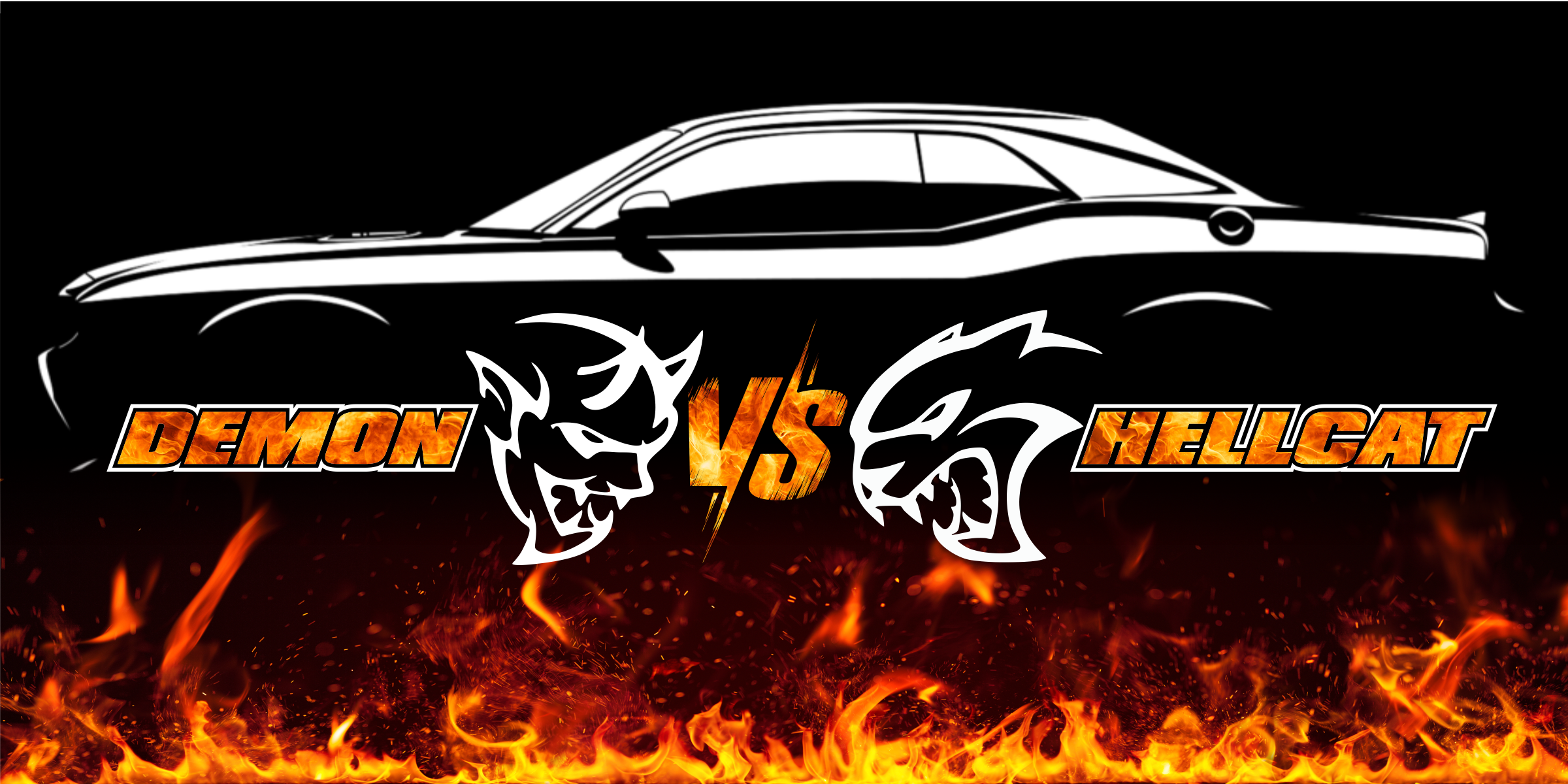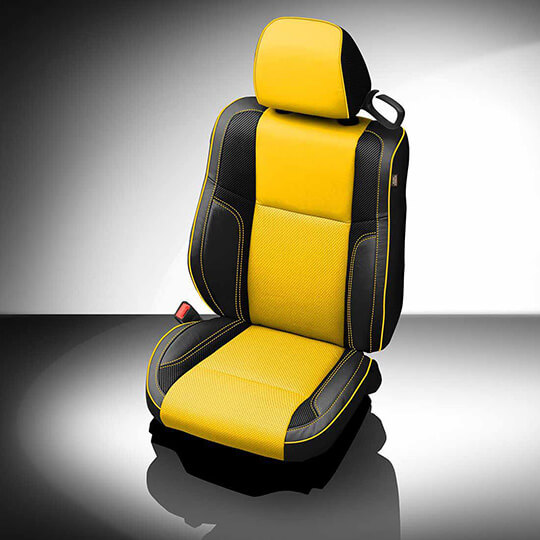
The Dodge Challenger is a favorite among muscle car enthusiasts, and that’s especially the case when you’re looking at the Challenger Hellcat vs Demon. Both these models of the Challenger come from Dodge’s Street and Racing Technology (SRT) division of Dodge, which is known for producing some of the coolest, high-performance cars in America. And whether you’re looking at the Hellcat or Demon, it’s plain to see that both are (pardon our French) cool as hell.
As SRT models, the Demon and Hellcat are filled with cutting-edge tech and precision craftsmanship. But how do the Hellcat vs Demon compare to one another? Read along to learn everything about these cool muscle cars from track times to engine size and everything in between.
Engine Size and Specs
Whether you’re riding behind the wheel of the Dodge Challenger Hellcat or Demon, you can be sure that you’ll feel the power of the engine the moment you put the pedal to the metal. One of the big differences you’ll see in the Dodge Demon vs Hellcat is in their engines. The Challenger Hellcat comes with a supercharged 6.2-liter V8 engine, which produces around 650 pound-per-feet of torque and 707 hp. The 2023 Hellcat comes with further options for massive power. The Hellcat Redeye’s engine produces 707 hp and the Hellcat Redeye Widebody Jailbreak edition produces 807 hp.
If you think that’s impressive, wait until you hear about the upcoming Demon. The last time the Demon was produced was in 2018 when only 3300 copies were made. For 2024, the Demon 170 is being reincarnated as Dodge says goodbye to its excessive muscle car models. The Dodge Challenger SRT Demon 170 comes with an even more powerful supercharged 6.2-liter V8 engine that produces 945 pound-per-feet of torque and an astounding 1025 hp with the use of E85. But if E85 isn’t available, 91-octane still provides 900 hp and 810 pound-feet of torque.
Top Speed
For the average driver, the top speed of your car is more theoretical than anything. You’re not likely to exceed 80 mph on your commute to work. However, drivers of the Hellcat and Demon aren’t the average driver, are they? These SRT muscle cars are made for drag racing, where top speed is critical. So when it comes to the Dodge Demon vs Hellcat, how do their top speeds compare?
First up, the Hellcat reaches an impressive top speed of around 203 miles per hour. Any police officer would pull you over well before reaching those speeds. Still, the Demon goes even faster. We don’t have the specs for the 2024 model, but the 2018 Demon pushed that top speed to 211 mph. We can only imagine how the 2024 Demon 170 will push the top speed.
0-60 times
Another spec all muscle car fans are dying to know is just how quickly these super fast cars can go from 0 to 60. Both the Hellcat and the Demon get moving insanely fast, but the Demon takes the cake once again. The Hellcat moves from 0 to 60 in 3.6 seconds, which is pretty impressive already. Meanwhile, the Demon shaves off almost two full seconds, reaching 60 mph in 1.66 seconds. Although Dodge performed this test on a specially-prepared surface, the time is still astounding.
Prices
You know if you’re buying one of Dodge’s SRT vehicles that you’re going to be shelling out some dough. But exactly how much does the Hellcat versus Demon cost?
If you’re planning to purchase a 2023 Dodge Challenger Hellcat, expect prices to start at $69,895. That’s just the base model of the Hellcat. If you opt for any of the higher packages, you could spend up to $90,495 for the Super Stock.
The 2024 Demon, on the other hand, starts at a whopping $100,361. And because it’s souped up as is, there are only a few add-ons. For an additional $11,495, you can get the lightweight wheels package, which removes 25 pounds from the bulk of the Challenger. A street tire package is also planned, but the pricing hasn’t been released as of yet.
Exterior Differences
When it comes to the Hellcat vs Demon, the exterior is another area where the two muscle cars differ. The Hellcat’s design mixes modern and classic muscle car details. Its wide stance is accentuated by flared wheel arches and lines that go from trunk to hood. The iconic dual-snorkel hood draws inspiration from classic Mopar muscle cars, and both the LED headlands and sleek front grille contribute to the all-around coolness. The rear features a bold spoiler and quad exhaust tips that roar to life as the Hellcat fires up. Finally, the finishing touch is the unmistakable Hellcat badge, seen on both the exterior and in some interior details.
In comparison, the Demon’s exterior is focused on one goal: drag-strip domination. While it shares some design details with the Hellcat, the Demon looks distinct from its brother. The massive hood scoop channels air directly into the engine. Wider fenders, flares, and lightweight drag wheels wrapped in high-performance tires give the Demon a ready-to-pounce stance. Plus, the front fender-flares have a dot shaved off, which reduces the total weight of the car by 16 pounds. Finally, the Demon 170 boasts a Demon badge so there’s no mistaking that this is a verified beast.
Interior
Probably the biggest difference between the Hellcat vs Demon when it comes to the interior is the presence or lack of a passenger seat. The Hellcat comes with enough seating for 5, though the rear seats are a little tight for adults. The Demon, on the other hand, only comes with a single seat for the driver. A passenger seat can be added on for $1, but if you’re looking to win drag races, the added weight probably isn’t worth it.
Both the Hellcat and the Demon 170 have a similar interior look, with a driver-centric cockpit and a digital instrument cluster that will have you feeling like you’re on the track even when stuck in traffic. The Hellcat comes standard with cloth Houndstooth seats and the option to upgrade to Nappa or Laguna leather seats with the Hellcat logo. Probably the coolest option for the Hellcat is Black/Demonic Red Laguna leather with Demonic Red seat belts. The single seat that comes standard with the Demon is cloth, but like the Hellcat, the Demon can be upgraded to leather.
If you’ve purchased a lower trim level of the Dodge Challenger, Katzkin can help you transform the interior of your vehicle to look like the Demon or Hellcat for a fraction of the cost. Whether you’re looking for dual-tone red/black Nappa leather/suede seats, or something a little more unique, Katzkin will reupholster your vehicle with automotive leather that fits as well if it was factory-made. We have a variety of product options for you to choose from.
Custom Challenger Seat Options
Driving Experience
Now that we’ve compared the Dodge Demon vs Hellcat and all their specs, let’s talk about driving experience. With their supercharged V8 engines, both the Demon and the Hellcat are some of the most powerful vehicles on the road. The Demon has an edge over the Hellcat, but both cars may just give you a false sense of ego as you fly past the competition. The Demon has a more robust suspension system, which makes it more agile than the Hellcat. The Hellcat, on the other hand, is more comfortable to drive for your daily commute.
So which muscle car is better in the battle between the Hellcat vs Demon? The Demon bests the Hellcat in most categories, including hp, torque, engine, suspension, top speed, 0 to 60 time, and more. However, the Hellcat’s price is more affordable than the Demon. So which car is right for you? That depends on whether you’re looking for drag-racing supremacy or daily comfort.



